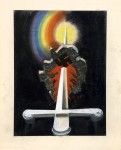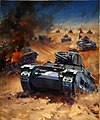 More than 350 original World War II artworks from the National Archives collection have been scanned and uploaded to Wikimedia. Wikimedia UK gave the National Archives a grant to take high resolution pictures of part of their 2000-piece collection of art created for Ministry of Information propaganda during the Second World War. The long-term goal is to scan the entire collection, but they’re starting off with 350 posters, drawings, oil paintings, portraits, and caricatures by well-known artists and talented artists who should be well-known, including famous images and slogans.
More than 350 original World War II artworks from the National Archives collection have been scanned and uploaded to Wikimedia. Wikimedia UK gave the National Archives a grant to take high resolution pictures of part of their 2000-piece collection of art created for Ministry of Information propaganda during the Second World War. The long-term goal is to scan the entire collection, but they’re starting off with 350 posters, drawings, oil paintings, portraits, and caricatures by well-known artists and talented artists who should be well-known, including famous images and slogans.
.
da THE HISTORY BLOG del 18 giugno 2012
.
The National Archives is hoping the new visibility of their collection will garner additional attention from scholars and the public. They’re also hoping the crowdsourcing power of Wiki will help them identify some of the unknown artists and fill in other informational blanks. Wikimedia is excited to have a whole new source of images to accompany old and new Wikipedia entries. Many of the artists in the collection who already have a Wikipedia page haven’t had any representations of their work on the page until now.
Some of the artworks have been classics of the propaganda poster genre, like the “Careless talk costs lives” posters from the campaign against sharing sensitive information with civilians (especially dangerous blondes). Others are sketches that were submitted to the Ministry but never published. You can see notes penciled in on the borders, among them a pointed critique of artistic license: “Bomb racks open from centre and not from side as in your sketch.”
There is a series of flattering oil portraits of Allied leaders about two-thirds of the way down on the second page by Austrian artist William Timym who moved from Vienna to London in 1938 after the Anschluss. He was naturalized a British citizen in 1949 and would later become known as the creator of the Bleep and Booster series of animated shorts.
It’s the more dramatic war scenes that most catch my eye. Terence Cuneo is widely collected today for his post-war paintings of railways and locomotives. He was also the official artist for the Coronation of Queen Elizabeth II. During the war he served as a combat engineer in the British Army and as an artist for the War Artists Advisory Committee. In the Wikimedia collection you can see his paintings of an invasion in the Far East, tanks in production, tanks in battle and most striking of all in subject matter at least, the 1942 assassination of Reinhard Heydrich, one of the main architects of the Final Solution.
One of my favorite pieces is an oil painting by Eve Kirk, a landscape painter and graphic designer whose wartime work showed at the Royal Academy in 1945. It depicts Tower Bridge and the Thames harbor protected by a sky full of barrage balloons. Barrage balloons were tethered balloons intended to collide with and damage low-flying, fast-moving aircraft like dive bombers. They were deployed in British cities starting in 1938. By 1940 there were almost 500 of them in the skies over London.
Then there are the symbolic illustrations, like the proud Aslan-like lion representing England painted by Tom Purvis, the British pincer cracking the swastika by Frank Newbould, the squirrels lining up to get their ration of coal by Clive Uptton, the British and Soviet arms strangling the German eagle rising from a bombed-out city by an unknown artist, and also by an unknown artist, this sort of dark Pink Floyd vision of a sword impaling a bleeding Germany through to a rainbow and sun behind.
GUARDA LA GALLERIA DI WIKIMEDIA COMMONS
____________________________
Inserito su www.storiainrete.com il 20 giugno 2012














